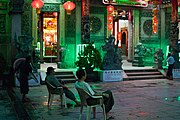The Kheng Hock Temple, also known as the Kheng Hock Keong (慶福宮), is the largest and oldest temple to the Chinese sea-goddess Mazu in Yangon, Burma. It is located on the corner of Sintodan Street and Strand Road in Latha Township. Kheng Hock Keong is maintained by a Hokkien Chinese clan association.[1] The temple attracts mostly Hokkien and Hakka worshipers, while the other temple in Latha Township, called the Guanyin Gumiao Temple, attracts Cantonese worshipers.
Establishment
It was originally built as a wooden temple in 1861 and completed in 1863, built in the Fujian style, on a tax-exempt plot of land granted by the British authorities.[2][3] The founding Kheng Hock Keong Trust Committee was composed of Rangoon's largest Hokkien clans, representing the Chan-Khoo, Lim, Tan, Yeo, Lee, and Su clans.[3] At the temple's founding, the primary deity was Guanyin. A new brick building was completed in 1903, costing over 153,000 rupees.[2]
Gallery
References
- ^ "Kheng Hock Keong".
- ^ a b Chen, Yi-Sein (1966). "The Chinese in Rangoon during the 18th and 19th Centuries". Essays Offered to G. H. Luce by His Colleagues and Friends in Honour of His Seventy-Fifth Birthday. Volume 1: Papers on Asian History, Religion, Languages, Literature, Music Folklore, and Anthropology. 23. Artibus Asiae Publishers: 107–111. doi:10.2307/1522640. JSTOR 1522640.
- ^ a b Li, Yi (2017-02-25). Chinese in Colonial Burma: A Migrant Community in A Multiethnic State. Springer. ISBN 9781137519009.
See also








Recent Comments